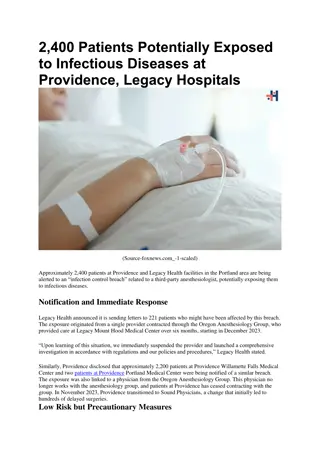
Males of Color Initiative in Providence Public Schools
Explore the Males of Color Initiative presented to the Providence School Board in May 2015, focusing on issues faced by males of color in education, partnership with My Brother's Keeper initiative, and data analysis on demographics and academic performance in Providence Public Schools.
Uploaded on | 1 Views
Download Presentation

Please find below an Image/Link to download the presentation.
The content on the website is provided AS IS for your information and personal use only. It may not be sold, licensed, or shared on other websites without obtaining consent from the author. If you encounter any issues during the download, it is possible that the publisher has removed the file from their server.
You are allowed to download the files provided on this website for personal or commercial use, subject to the condition that they are used lawfully. All files are the property of their respective owners.
The content on the website is provided AS IS for your information and personal use only. It may not be sold, licensed, or shared on other websites without obtaining consent from the author.
E N D
Presentation Transcript
Males of Color Initiative A Presentation to the Providence School Board May 11, 2015
Background Council of Great City Schools Males of Color Pledge Emerged from Trayvon Martin verdict in 2013 Pledge signed July 2014 by Superintendent Lusi and School Board President Oliveira Providence Public School District (PPSD) joins 59 other urban school districts Key Points: Recognition that academic achievement for Males of Color is well below what is expected for success in college and career Recognition that Males of Color are disproportionately suspended from school and exhibit higher chronic absenteeism PPSD committed to examining how issues of race, language and culture affect the work of our district
Linkage with My Brothers Keeper President Obama s My Brother s Keeper Initiative Mayor Taveras/City of Providence joined in 2014 Identifies persistent opportunity gaps faced by boys and young men of color Ensures all young people can reach their full potential Includes access to basic health, nutrition and high quality early education serves Relies on partnerships with local communities and police to reduce violence Goals include: Ensuring all students read at grade level by 3rdgrade Ensuring all youth graduate high school college- and career-ready Ensuring all out of school youth are employed Ensuring all youth remain safe from violent crime
Data Analysis Data compiled by the PPSD s Office of Research, Planning and Accountability special thanks to Dr. Marco Andrade Measures data from the 2013-14 School Year Includes: Population demographics of the School District Graduation Rates by Race and Gender Drop Out Rates by Race and Gender Attendance by Race and Gender Chronic Absenteeism by Race and Gender Out-of-School Suspension by Race and Gender AP Course Participation Rates by Race and Sex 2013 ReadiStep/PSAT Participation Rates by Race and Gender AP Course Participation Rates by Race and Sex
PPSD Population, SY 2013 -2014 80% Overall Population Demographics, 2013 - 2014 70% 64.7% 60% 50% 40% 33.7% 31.0% 30% 17.3% 20% 8.9% 8.8% 8.4% 10% 4.2% 4.7% 5.1% 4.1% 2.7% 2.2% 2.0% 2.4% 0% Asian Black Hispanic White Other Male Female Total Notes: Other category consists of Native American, Multi-Racial and Pacific Islander, which accounts for less than 5% of PPSD s total population Total n = 24,686 (n = total PPSD population , excluding charters and home instruction)
2014 Graduation Rates by Race and Gender 90% 87.0% Takeaways: Black males have the lowest graduation rate of all the racial subgroups 85% 80% 77.7% 75.5% 75.5% 74.5% 72.7% 75% 68.2% 70% 66.6% 65% 64.0% 59.0% 60% 55% Hispanic males have the third-lowest graduation rate of all the racial subgroups 50% 45% 40% Asian Black Hispanic Male White Other Female Notes: This chart represents 4-year graduation rates for the graduating class of 2014 Other category consists of Native American, Multi-Racial and Pacific Islander These rates include home instruction and in-district charters (ACE, Times 2 ) students Total n = 1270 (n = total graduates)
2014 Dropout Rates by Race and Gender 40% Takeaways: Black and Hispanic males have the highest dropout rate of the four primary racial subgroups 30% 28.0% 18.2% 20% 16.4% 16.1% 14.3% 14.3% 11.6% 10.7% 10% 8.7% 7.4% 0% Asian Black Hispanic White Other Male Female Notes: This chart represents 4-year graduation rates for the graduating class of 2014 Other category consists of Native American, Multi-Racial and Pacific Islander These rates include home instruction and in-district charters (ACE, Times 2 ) students Total n = 246 (n = total dropouts)
SY 2013-14 Attendance Rates by Race and Gender Takeaways: The gaps between Black and Hispanic males versus Black and Hispanic females is less than 1% point The gap between Black and Hispanic male attendance and the highest attendance rate is less than 3% points 95% 92.7% 92.4% 91.8% 91.2% 91.2% 90.7% 90.5% 90.1% 89.6% 85% Male Female Notes : Native American and Pacific Islander data suppressed due to low numbers in population Chart includes students enrolled at PPSD at any point in SY13-14 Total n = 24,686 (n = total PPSD population, excluding charters and home instruction)
SY 201314 Chronic Absence Rates by Race and Gender 50% Takeaways: Hispanic males have the third-highest rate of chronic absence, behind multi-racial males and females Black males have the second lowest rate of chronic absence among males, and the fourth lowest rate overall 45% 38.4% 40% 32.7% 35% 33.0% 31.1% 30.4% 30.5% 28.6% 30% 26.5% 23.5% 25% 23.0% 20% 15% 10% 5% 0% Male Female Notes : Native American and Pacific Islander data suppressed due to low numbers in population Chart includes students enrolled at PPSD at any point in SY13-14 Total n = 23,858 (n = total PPSD population excluding charters and home instruction)
SY 2013 14 Out of School Suspension Data by Race and Gender 30% 1 Suspension 2+ Suspensions 20% 11.3% 10% 6.5% 8.9% 5.1% 5.1% 5.5% 2.9% 10.2% 2.0% 0.5% 8.0% 2.2% 7.0% 5.8% 5.7% 5.2% 4.7% 2.6% 2.3% 2.0% 0% Takeaways: Black males are disproportionately suspended compared to other racial subgroups. Hispanic males have the third-highest rates of OSS. Notes :Native American and Pacific Islander data suppressed due to low numbers in population Total n = 24,435 (n = total PPSD population excluding charters and home instruction)
2013 ReadiStep/PSAT Participation Rates by Race and Gender 80% Takeaways: Hispanic males had the second- lowest participation rate for ReadiStep/PSAT 70% 58.1% 58.2% 55.6% 60% 53.4% 53.8% 53.7% 50.5% 50.5% 50% 46.3% 44.0% 40% 30% 20% 10% 0% Male Female Notes: Native American and Pacific Islander data suppressed due to low numbers in population Students in grade 9 take the CollegeBoard ReadiStep; students in grades 10-11 take PSAT. Total n = 6,969 (n = students grades 9-11, excluding charters and home instruction)
SY 2013 14 AP Course Participation Rates by Race and Gender 40% Takeaways: AP Course Participation is an indicator for future college enrollment. Hispanic males had the lowest AP participation rates of all the subgroups Black males had the third-lowest AP participation rates of all the subgroups 35% 30% 26.1% 23.7% 25% 18.6% 20% 14.8% 15% 11.8% 11.0% 10.1% 10% 8.4% 6.2% 6.6% 5% 0% Male Female Notes: Chart indicate rates of participation in at least 1 AP course Native American and Pacific Islander data suppressed due to low numbers in population Total n = 9,111 (n = total high school students ,excluding charters and home instruction)
Data Findings Males of Color in Providence Schools: have lower graduation rates have higher drop out rates are disproportionately suspended from school have lower attendance than the district average are chronically absent more than other groups participate less in PSAT and other college prep tests participate less in Advanced Placement (college prep) courses
Males of Color Implementation Plan Draft Policy on Institutionalized Racial Equity Equality: Everyone gets a pair of shoes. Equity: Everyone gets a pair of shoes that fit. Acknowledgement that inequities exist in PPSD practices and procedures resulting in lower academic achievement for Males of Color Identify and eliminate racial inequities Racial Equity becomes an embedded value within the District
Males of Color Implementation Plan Institutional Equity (continued) School Board will consider adoption of Policy on Institutionalized Equity School Board will engage in broad community discussion of how race, language and culture affect the district Town hall forums and public hearings to gain feedback Data Collection Tracking progress of performance indicators; examples include: Academic Achievement and Attendance Graduation Rates and Drop Out Rates FAFSA Completions and PSAT Participation Student Discipline Referrals Special Education Referrals
Males of Color Implementation Plan Culturally Reflective Curriculum Coursework with greater cultural relevance Greater Role and Presence of Men of Color More involvement from parents and community leaders Recognition of the value of these important contributions Address Student Discipline Review of District Code of Conduct IN PROGRESS Ensure policies are fair and equitable MOU between PPSD and Providence Police COMPLETED Greater discretion for school principals Training for teachers and administrators Restorative Practices
Males of Color Initiative THANK YOU!






















